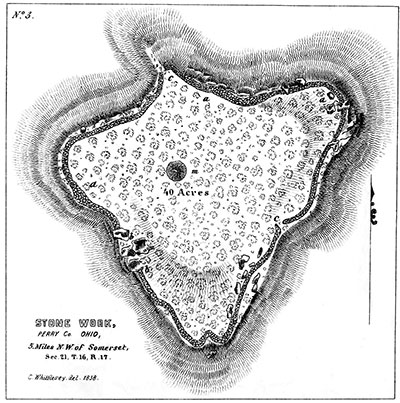PLATE V. No. 3.
STONE WORK, PERRY COUNTY, OHIO.
[Today this is known as Glenford Fort.]
This is found in Perry County, five miles north-west of Somerset, Sec. 21, T. 16, R 17.
The wall is, and must have been very slight, not, on an average, as large as the stone fence of the New England farmer. The stones may have been heaped to- gether with more regularity than they now present, but were not dressed. At the points, a, a, a, the wall increases in volume, like a mound or tower; but, in general, it is not above one foot high and ten feet broad; its greatest height does not exceed four feet. The ground is not strictly inaccessible, but difficult of approach, and at the steepest places the wall is built close to the edge of the bluff.
At b, b, the rock, a coarse conglomerate, is bare, and a perpendicular fall, of several feet, is exhibited, with large detached blocks, and here there is no wall. At several other points, large detached blocks, not transported, but in place, form part of the wall. The builders do not appear to have employed great mechanical forces, for detached rocks, and such as two or three yoke of oxen could move, are left within a few feet of the wall, while smaller stones from a distance are used. The rough stones of the wall were found convenient, having fallen from the rocky cliffs, on which the work is built.
The interior space of the enclosure is higher than the exterior, and the whole thickly covered with timber.
A little west of the center is a mound of loose stone, m, fifteen feet high. The principal entrance is at the north-west angle, c, where the ascent along a ridge is less than elsewhere, but is still laborious. The work is at least one-fourth of a mile from water, the hill is from three to four hundred feet above the adjacent valleys, and detached from other hills.
The position indicates it to be a fortress, which was not completed or occupied. With a heavy wall, a resolute garrison, well supplied with water and provisions, could here make a protracted defense. I do not think palisades could have been inserted in the wall, for it was not strong enough to sustain them; and, in general, they could not have been sunk beneath the surface, for it is solid rock.
If "abattis," or other wooden obstructions were relied upon, the wall would have been of little service; but its outline being traced, a few thousand men, in an emergency, could, from the loose rocks of the cliffs, have made a formidable wall, in one night. To this enlarged work they might have added wooden defenses of some kind. This sketch was made by examining the perimeter in detail, and noting its parts by the eye, and short measurements; its dimensions are, therefore, not strictly exact.


